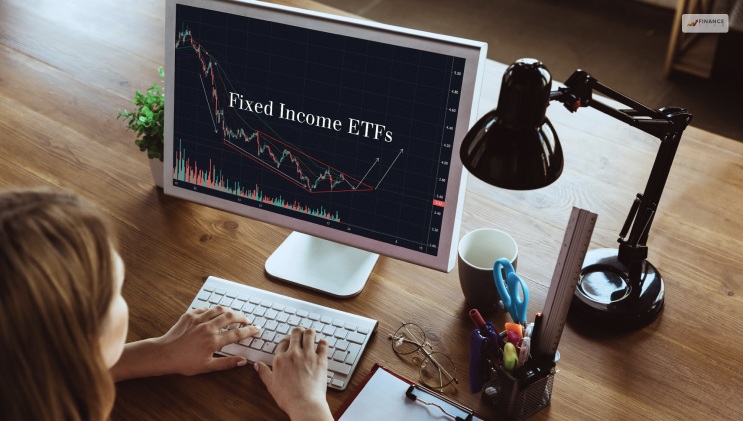The Importance Of Fixed Income ETFs In Today’s Environment
January 20, 2024

In the last two years, central banks from around the world have stuck to aggressive policy responses. This led to higher rates than usual. Therefore, there has been a rise in fixed-income assets, as these play a fundamental role in various investors’ portfolios. Furthermore, investors can now better access entry points to fixed-income products. Also, experts feel that the next phases of monetary policy can be beneficial for these products. Let’s understand about Fixed-Income ETFs.
In this article, you will learn about fixed-income ETFs (exchange-traded funds) in general and how they work in today’s business environment. However, before that, we will define what includes a fixed-income product or an asset. Apart from that, you will also learn the major benefits of choosing fixed-income assets. Finally, we will share with you the major pros and cons of fixed income investing. Hence, to learn more, read on through to the end of the article.
What Is Fixed Income?

According to Investopedia,
“Fixed income broadly refers to those types of investment security that pay investors fixed interest or dividend payments until their maturity date. At maturity, investors are repaid the principal amount they had invested. Government and corporate bonds are the most common types of fixed-income products.”
As the name suggests, fixed-income securities offer payments that remain fixed throughout, and the investors know that in advance. On the other hand, in securities with variable income, the payments may change with underlying measures. If you want to purchase fixed-income securities, there are various options for you to choose from.
Apart from purchasing fixed-income securities directly, you can purchase fixed-income exchange-traded funds (ETFs) and mutual funds. These options are easily available to investors of all levels. Such securities include a class of assets that pay out a set level of cash to investors. These set levels of cash come in the form of fixed interest or fixed dividends.
Some of the major examples of fixed-income assets include government bonds and corporate bonds. These bonds pay a fixed rate of interest to investors. Also, when these types of securities mature, they repay the principal amount to investors of what they have invested before. This also includes the interest. In case a company faces bankruptcy, it pays first to its fixed-income investors before common stockholders.
Fixed-income securities are the best options for conservative investors who are looking to diversify portfolios. However, the investor’s style of investment determines the percentage of portfolio dedicated to fixed income. Apart from that, an investor can also consider diversifying the portfolio with a combination of fixed-income assets and stocks.
What Are Fixed-Income ETFs?

Investors who want good exposure to the equity market go for exchange-traded funds (ETFs). However, ETFs are not always the first option for bond allocation. Many try to choose fixed-income ETFs because of the benefits they offer.
If you are looking to diversify your portfolio and want to add liquid bond exposure to it, you can choose to invest in fixed-income ETFs. This is because they are simple and offer greater transparency. You will not find the latter directly in the global bond market.
Apart from transparent pricing and holdings, fixed-income ETFs also come with low management fees, tax efficiency, and more. You can also trade those fixed-income ETFs on the stock exchange. Although, initially, equities were the main motivation behind the formation of ETFs. However, with time, ETF providers started offering fixed-income ETFs that contain different classes of assets.
One of the things that makes fixed-income ETFs a good option for investors is that they are not only liquid but also easy to trade, just like ETFs. On the other hand, the bond market is not as liquid or transparent as the equity market. Furthermore, like stocks, fixed-income products do not trade on an exchange. Here, fixed-income ETFs offer both options.
However, before you invest in a fixed-income ETF, you will need to understand its various categories:
- Sovereign: These are the ETFs that target fixed-income security issues. These issues belong to sovereign governments, like US Treasuries.
- Corporate: These ETFs target fixed-income securities of business corporations.
- Municipals: Various municipalities in the United States issue fixed-income securities. Municipal ETFs target these securities.
- Broad Market: These ETFs have good exposure to sovereign debts as well as corporate debts.
How Do Fixed-Income ETFs Work?

According to JP Morgan,
“Although exchange-traded funds (ETFs) are hugely popular among investors looking for equity market exposure, they aren’t always the first port of call when it comes to bond allocations. However, fixed income ETFs offer several benefits for anyone looking to add diversified and liquid bond exposure to their investment portfolio – with a level of simplicity and transparency that isn’t possible by investing in global bond markets directly.”
In fixed-income ETFs, the fund holds a fraction of the bonds that are trading in an index. The difference between a general ETF and a fixed-income ETF is that the latter pays fixed interests and dividends to investors. If an investor is looking for a steady stream of income from a diverse set of stocks, fixed-income ETFs are good options to invest in. They are basically a special type of mutual fund with the help of which you can track the performance of certain bond indices.
The creation of fixed-income ETFs runs with the mechanism that ensures that the prices of ETFs remain always close to fair value. However, if an ETF trades above the fair value, authorized participants get the incentive to create new shares. They do so by delivering the basket of bonds to the issuer of the ETF. As a result, they increase the supply of ETF shares and drive the price of the fixed-income ETF close to fair value. This also applies when prices are lower.
What Are The Benefits Of Choosing Fixed-Income ETFs?

Fidelity.com states –
“Fixed income investing can be a particularly good option if you’re living on an actual fixed income and looking for ways to maximize your savings. And if you’re worried about the potential wild ups and downs of the stock market, fixed income investing can help you sleep a bit better at night.”
Fixed-income ETFs offer access to a diverse fixed-income portfolio. Once you buy such a diverse basket of fixed-income securities, you will generally need to invest a lot. However, with a fixed-income ETF, this is not the case. Furthermore, you will also be able to implement allocation decisions quickly and effectively. Apart from that, you can also use these ETFs to learn more about the larger bond market.
Also, fixed-income ETFs go through trading thousands of times throughout the day on a single exchange. On the other hand, individual bonds do not operate like that daily and fall under over-the-counter transactions. On the other hand, these ETFs offer internal diversification and access to different sectors.
How To Invest In Fixed-Income ETFs?

Investopedia adds –
“Investors looking to add fixed-income securities to their portfolios have several options. Today, most brokers offer customers direct access to a range of bond markets, from Treasuries to corporate bonds to munis. For those who do not want to select individual bonds, Fixed-income mutual funds (bond funds) give exposure to various bonds and debt instruments.”
Apart from that, with these ETFs, you will also get exposure to a lot of bonds and debt instruments. Also, with the help of these funds, you will also have a steady stream of income. In addition to that, these ETFs are cost-effective for individual investors at the same time. Fixed-income ETFs basically target specific credit ratings, durations, and more. Furthermore, the investor needs to carry some expenses for professional management.
You can do this type of investing through a conservative strategy. Here, you can generate returns from low-risk securities that offer you predictable rates of interest. Since there is a lower amount of risk, you will also need to pay less for interest coupon payments. You can also use the laddering strategy to invest in fixed-income ETFs as well as other assets.
With the strategy’s help, you will generate steady income through interest rates. You can do that with a series of short-term bonds. After the maturity of the bonds, the portfolio manager will reinvest the returns into short-term bonds. This will help in the extension of the ladder.
Hence, with the help of this method, an investor will be able to access a good amount of capital. Also, the investor will not lose out if interest in the market rises.
Analyzing Your Fixed Income
Before you decide to invest in a fixed-income ETF, you need to perform a fixed-income analysis. With the help of this analysis, you can assess whether you are comfortable with the risk level. Furthermore, you can also analyze whether this risk level is worth the income security’s return.
Different securities have different features. Hence, all these are appealing from different POVs. Hence, it is essential to consider what works best for you in the given situation.
Pros And Cons Of Fixed-Income Investing
The following are the major pros and cons of fixed-income ETFs that you need to learn about:
Cons Of Fixed-Income ETFs
Here are some of the major pros of investing in fixed-income exchange-traded funds (ETFs) that you will benefit from:
- The most important advantage of fixed-income ETFs is that they offer a steady source of income to investors. The best thing here is that you can earn a steady income over the life of the ETF. Furthermore, you can have good access to money and capital at the same time. By having a constant source of income, investors can also be able to plan for their spending.
- By investing in a fixed-income ETF, you will have access to a diverse portfolio. Furthermore, you will not have to invest a lot of capital in the same. Hence, you will get the necessary exposure to a variety of sectors.
- On the other hand, you will not have to pay a lot of fees to fund managers since these ETFs do not require a lot of management. Also, you will have a steady source of income through these ETFs.
- After the ETFs maturity, you will get the principal and interest amounts.
- One of the best things about fixed-income ETFs is that there is transparency in pricing and holdings.
- There is also good flexibility and liquidity due to the intraday trading ability of fixed-income ETFs.
- You will also get tax efficiency with fixed-income ETFs, which are not available with other investment options.
Cons Of Fixed-Income ETFs
Like any asset, investing in fixed-income ETFs also has risks. Generally, the factors that influence bond prices also influence ETF shares. Here are a few cons of fixed-income ETFs that you need to be aware of:
- If interests are on the rise, it means the price of bonds will decline and vice versa. Hence, there is a change in future cash flows as well, which further affects prices in the market.
- Although fixed-income investors are the first ones to get a return for investments, there is still a catch. Here, if the company becomes a defaulter and is unable to pay it back. Hence, it is important to look at the credit ratings of bonds before investing. You can lessen this risk by diversification.
- There are prepayment risks with fixed-income ETFs, too. This can occur due to cash flow uncertainties and exposure to reinvestment risks.
- Like every other form of investment, there is also a risk of a decline in the market. Hence, despite having strong fundamentals, an investment can face a lot of problems as well. Other factors like inflation also affect the prices of fixed-income ETFs.
Bottom Line
Hope this article was helpful for you in giving you a better idea of the importance of fixed-income ETFs in today’s environment. Due to the volatility in the market, it has become essential for investors to have a fixed source of income. Hence, investors can be sure of an income source with fewer expenses.
Do you have some more suggestions on fixed-income ETFs? Consider sharing them with us in the comments section below.
Read More About More Finance Articles By Clicking Below!!










